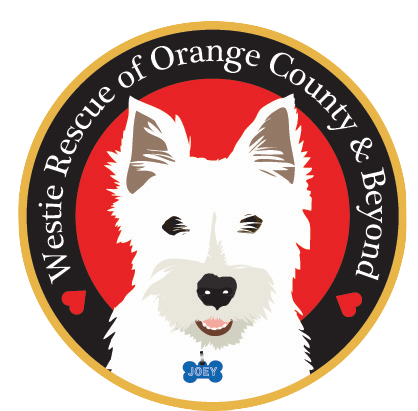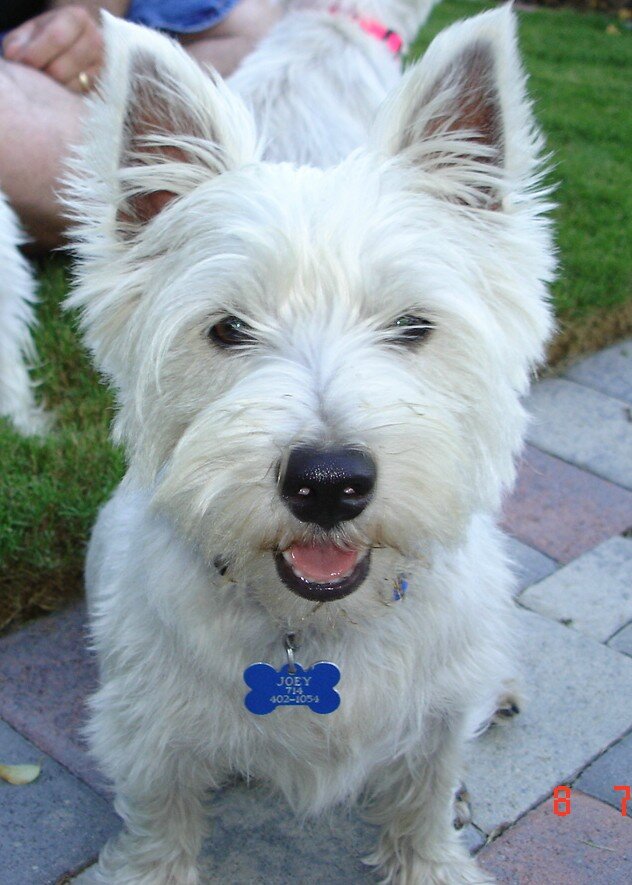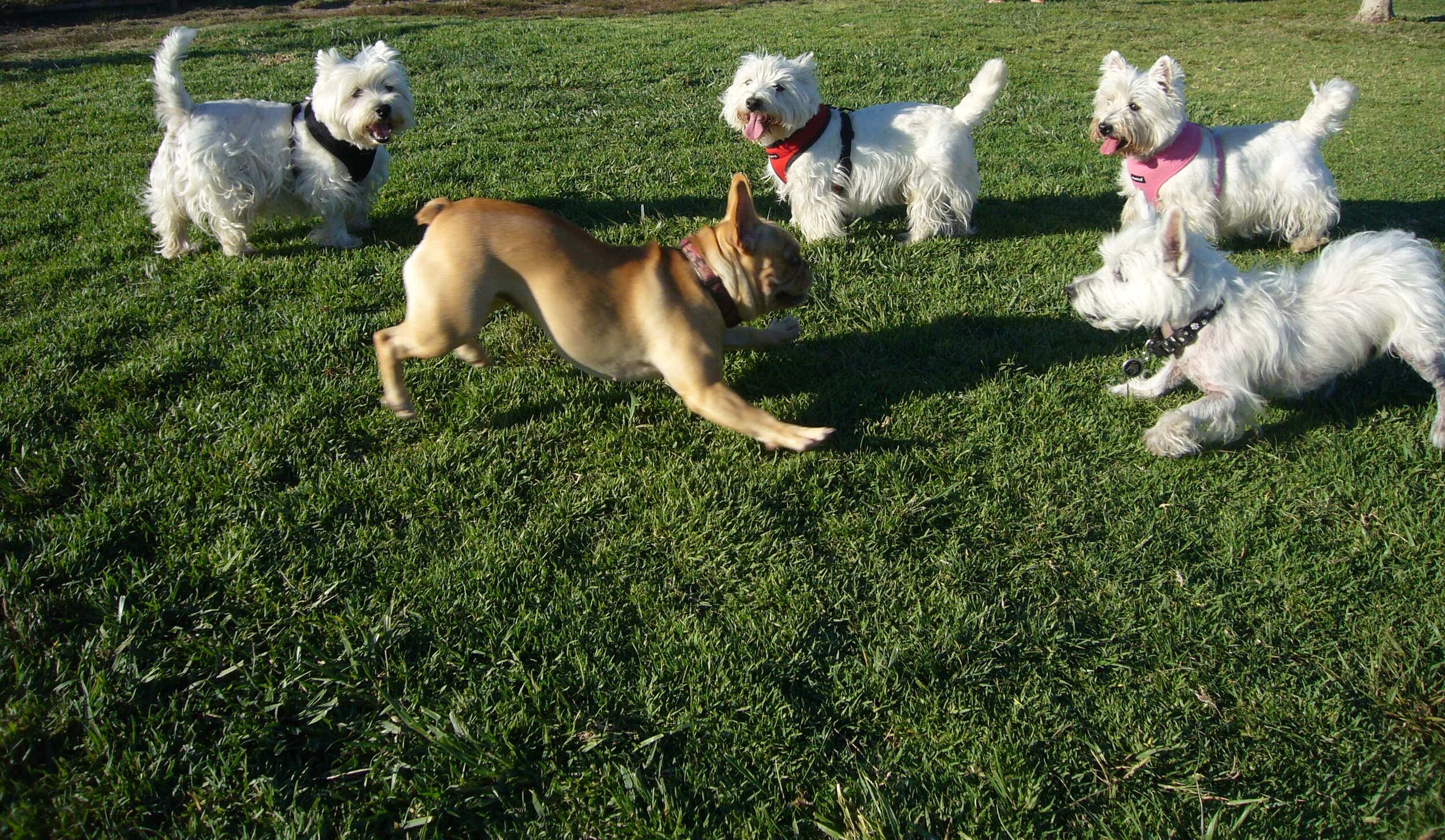
THE WESTIE DIET
Recipes from the Rescue Kitchen
These delicious recipes were developed exclusively by Westie Rescue of Orange County & Beyond and will tempt even the most finicky eater!
Dan’s Highlander Hash
INGREDIENTS:
½ pound ground turkey (you may also use salmon or tilapia)
1 raw carrot, quartered and chopped into ¼ inch slices
1 raw zucchini, quartered and chopped into ¼ inch slices
1 raw yellow squash, quartered and chopped into ¼ inch slices
1 medium apple, cored & chopped into ¼ inch slices
2 Tbsps chopped fresh parsley & ½ tsp ground turmeric
DIRECTIONS:
Brown ground turkey over medium heat in a 12 inch non-stick pan for 3-4 minutes, stirring constantly, breaking up the turkey. Add carrot, zucchini, squash, and apple. Cook 5 minutes, stirring frequently. Add parsley & turmeric and cook 2 minutes more, continuing to stir. Cool and serve. This recipe freezes well. We serve 1-2 Tbsps on top of 1/3 cup kibble.
Stanley’s Wild About Salmon
INGREDIENTS:
1/2 pound Alaskan Salmon Fillet
12 oz frozen peas & carrots
12 oz frozen cut green beans
DIRECTIONS:
Preheat oven at 350 degrees. Wrap salmon in foil and bake 20 minutes or until salmon becomes opaque and flakes easily. Steam frozen vegetables in a large pot. The water in the frozen vegetables will contribute to the steaming process. When done, shred the salmon with a fork, and mix with the vegetables.
Serve 1-2 Tbsp on 1/3 cup kibble per meal. Keep refrigerated and reheat in the microwave. This recipe freezes well
Perry’s No-peek Chicken & Rice
INGREDIENTS:
1 pound skinless/boneless chicken breast
8 cups chicken broth OR water OR vegetable broth
5 carrots chopped in 1/4 slices
3 stalks celery chopped in 1/4 slices
2 medium red potatoes (or white) cut in 1/4 cubes
2 cups uncooked brown rice
DIRECTIONS:
Place all ingredients except for brown rice in crockpot & cook on high for 1 1/2 hours. Remove chicken and shred, return to pot, add rice and cook another 1 1/2 hours. Remove from heat, stir & let cool for 1 hour before serving. This recipe freezes well and can be cut in half. Serve 1-2 Tbsp on top of 1/3 cup kibble.
About the Westie Diet
ONE SIZE DOES NOT FIT ALL. Westie Rescue of Orange County & Beyond has done a great deal of research on the diet for our Westies. We have spoken with many veterinarians, dieticians, and food experts. What we find is there is a lot of controversy with what diet to feed your Westie. What we know for sure is that there is not one particular diet that will work for all dogs. Each dog is unique with unique requirements. We are constantly researching for the highest quality foods & never get stuck in a rut if better foods become available.
Considerations are health issues, age, and activity level
Another very important factor to consider is a Westie with skin allergies. Special diets have been derived as a result of skin problems relating to allergies which are quite common in the Westie breed. We do not recommend a diet that contains:
beef
corn
wheat
brewers yeast
gluten
soy
meat by-products or poultry by-products
meat meal (which is different from chicken meal, beef meal, etc - meat meal is non specific) Better meals are typically made from the meat of clearly identified sources. Low-grade meals come from anonymous materials
garlic
artificial colors or preservatives
dyes, specifically Red 40, Red 3, Yellow 5, Yellow 6
vitamin pre-mixes
propylene glycol
Since each dogs needs are different, we use several different recipes in preparation of meals based upon those specific needs. Since we forever foster many senior and geriatric dogs, we also take into consideration a variety of ingredients rich in antioxidants and anti-inflammatory properties. Inflammation is a major cause of disease so it’s important to research all ingredients in your dog’s diet, along with the manufacturing processes. (More on that later)
If you are using a commercial food it’s best to add naturally anti-inflammatory whole foods into the mix. Whole foods high in antioxidants also help reduce inflammation in the body.
CHOOSE QUALITY INGREDIENTS
Grocery store food is almost a guarantee to be made from ingredients you do not want to feed your dog. Feeding low quality food could lead to skin problems, dull coat and eventually health problems.
There is a lot of truth to the idea that you get what you pay for with dog food. Price is often an indication of quality however some companies mark up their prices to look premium. It is important to know the nutritional needs of your dog.
Some of these foods are more expensive than others but once you are looking at food in this range, simply choosing the most expensive food is not the best way to choose a food for your dog. Prescription diets are often the most expensive dog foods available but they are only for dogs who have special health problems.
Know the ingredients. You will be able to tell if the food is high quality or not. The top 5 ingredients are what matters the most. Look for whole meats which will be labeled as chicken, beef, lamb, salmon, etc. This is premium and may be human grade meat. Steer clear from meat meal, and by-products.
Dog food reviews and ratings can be found at www.dogfoodadvisor.com
FAT IS NOT FIT
Obesity is an extremely common problem in pets and, as humans, can be detrimental to the health of a dog. The overweight pet has many added stresses upon his body and is at an increased risk of diabetes, liver problems and joint pain.
As a subjective assessment of your pet's body condition, you should be able to feel the backbone and palpate the ribs in an animal of healthy weight. If you cannot feel your pet’s ribs without pressing, there is too much fat. Also, you should see a noticeable "waist" between the back of the rib cage and the hips when looking at your pet from above. Viewed from the side, there should be a "tuck" in the tummy—the abdomen should go up from the bottom of the rib cage to inside the thighs. Dogs who fail these simple tests may be overweight.
Although most weight gain in dogs is simply due to feeding too much or exercising too little, there are medical conditions which can contribute to obesity. Many of these conditions can be treated. If your dog has an unexplained increase in appetite or weight, have your dog examined by your vet to be sure there is not a medical reason causing the problems. The checkup will rule out health problems that can cause weight gain, such as hypothyroidism, and the weigh-in will help you figure out how much he needs to lose.
ARE YOU MAKING YOUR DOG FAT?
Genetics do play a roll, but another non-genetic reason for an overweight dog is more obvious; YOU, the owner, may be overindulging your pet, most likely with treats or people food. Often, it is not the dogs' official food that is causing the weight problem; it is the additional treats & snacks between meals. A kiss instead of a cookie goes a long way!
WHERE TO START
Dogs need different types and amounts of food during their life stages. Younger dogs require more energy, protein, and minerals than older dogs. Active field trial dogs would have greater energy needs than older dogs. Older dogs, even if they remain active, may require fewer calories than when they were younger.
Help him feel satisfied by adding low-calorie, high-fiber foods to his bowl. These can include fresh steamed green beans, low-sodium canned green beans, and plain canned pumpkin. Your dog will still feel as if he's getting a lot of food; he just won't be taking in as many calories.
HOW MUCH
A diet starts in earnest after you've cut back on his food by one-third to one-half. Stick with this plan until he reaches a healthy weight. In spite of those pleading looks, your dog will not starve. Also, keep in mind that the amount recommended on the bag of food is only a starting point. Dogs are individuals, and the amount they need to eat depends on a number of factors, including their metabolism, the type of food they eat, their age, how much exercise they get, and what the climate's like where they live. So after he loses his excess weight, continue adjusting the amount of food he gets until you find an amount that can sustain a healthy weight.
CHOOSE HEALTHY
The 'average' calorie need of an 'active' 18-pound dog is 605 kcal per day based on 420 kcal per cup. Giving that 18-pound dog just one medium Milk-bone morning and night equals 80 kcals. Calories from treats pile up pretty fast, and the ingredients are full of by-products, salt, and artificial color and flavoring. (We don't feed Milk-bone - used as an example only!) When selecting treats, be calorie-conscious & aware of the nutritional value and be sure that treats do not make up more than 10% of your pet's daily intake. Remember, your pet cannot open the freezer, or scrape the dishes. A better treat choice would be a medium baby-sized carrot at just 3 kcals each or apple slices. There are healthy treats on the market that contain wholesome fruits and veggies. Look for wheat-free treats that contain NO corn, soy, artificial colors, flavors, hormones, antibiotics, preservatives, coloring, salt or sugar.
Often times packaging labels will say "Made in the USA". This does not mean the ingredients come from the U.S., but rather the treats are manufactured in a US facility. With all the dog food recalls, we are only confident in choices from Orijen, Primal, Charlee Bears or Happy Dog which carries a chicken treat which is dehydrated white chicken meat (its' ONLY ingredient!) that is 80% protein and only 3% crude fat. Stay away from grocery store bought dog treats. The ingredients in these treats will make your stomach turn! Green beans, apples, carrots , watermelon or home made treats are your best options!
OWNER BEHAVIOR MODIFICATION
Successful weight management requires permanent changes in the behaviors that have allowed the pet to become overweight. Let's face it, people like to give their pets treats. This is not all bad. Treats are often helpful as training aids and can be used to distract pets undergoing procedures such as removing mats, trimming nails, etc. Sometimes, we give dog treats as a health benefit. And sometimes, it is just fun to give pets something special. Unfortunately, the type of treat or amount given can result in our pets receiving too many calories.
EXERCISE
Activity levels plays a major role in determining the caloric needs of a dog and thus his tendency to become overweight. An active dog will use more calories. Increasing physical activity can be a valuable contributor to both weight loss and maintenance. Regular exercise burns more calories, reduces appetite, changes body composition and will increase your pet's resting metabolic rate. Exercise reduces stress and boredom!



